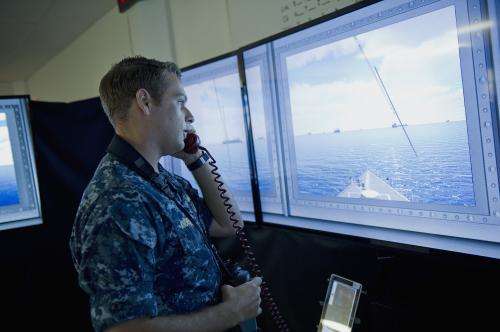Mission possible: Simulation-based training and experimentation on display

A unique system that merges the virtual and real worlds to train Sailors for combat scenarios was unveiled Dec. 2 in Orlando.
The Office of Naval Research (ONR) is demonstrating the Fleet Integrated Synthetic Training/Testing Facility (FIST2FAC) at the Interservice/Industry Training, Simulation and Education Conference, commonly referred to as I/ITSEC. Chief of Naval Research Rear Adm. Matthew L. Klunder will discuss FIST2FAC and training technologies for the future during a special panel 2 p.m. Tuesday, Dec. 3.
FIST2FAC provides an affordable, adaptive way to train. It combines a hassle-free setup, software and gaming technology to help naval forces develop strategies for a variety of missions and operations.
"This is the future of training for the Navy," said Dr. Terry Allard, head of ONR's Warfighter Performance Department. "With simulation, you can explore endless possibilities without the expense and logistical challenges of putting hundreds of ships at sea and aircraft in the sky."
FIST2FAC allows Sailors to interact with artificially intelligent forces in countless settings and train for multiple missions simultaneously. The system can replicate simple and complex situations involving aircraft carriers, helicopters, lethal and nonlethal weapons, and more.
A recent scenario demonstrated at Ford Island, Hawaii, pitted a ship's crew against several fast-attack craft in waters crowded with merchant traffic. Sailors quickly determined the boats to be hostile and engaged them with machine-gun fire from the virtual ship.
"FIST2FAC allows Sailors to 'train like they fight' by presenting realistic forces in a visual, tactical and operational environment," said Glenn White, ONR's integration and transition manager for the project.
Swarming attack boats is one of several tactics Navy leaders hope to overcome through an Anti-Access/Area Denial (A2/AD) strategy to counter threats from adversaries trying to restrict the access and movement of U.S. forces.
"A2/AD is a really challenging problem," Allard said. "With simulation, we can help the experts be more innovative in defining what tactics, techniques and procedures will go into a successful A2/AD strategy."
In addition to the fast-attack craft threat, FIST2FAC has been used to simulate anti-submarine warfare and strike group operations with aircraft carriers, destroyers and helicopters. Soon, the system will address electronic, mine and anti-air warfare scenarios.
"Currently, all of this is shore-based, but the goal is to make this capability available on ships at sea," White said.
The robust training and affordability of FIST2FAC aligns with the tenets put forth in the Chief of Naval Operations' 2014-2018 Navigation Plan. It is the result of partnerships between ONR, the Naval Undersea Warfare Center Keyport Division, U.S. Pacific Fleet and the Naval Warfare Development Command.
Provided by Office of Naval Research


















